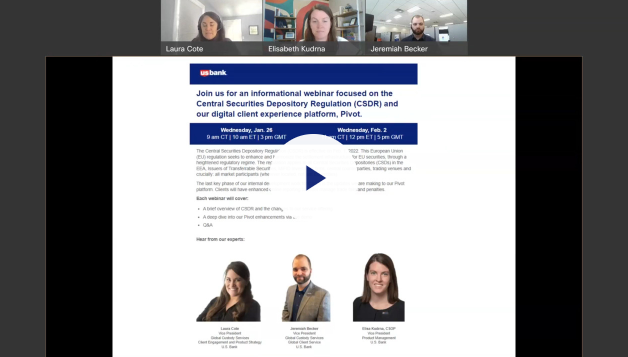The global market is always changing, with new opportunities and challenges arising every day. Here are several of the major risk factors in international trade to consider.
By Jane Hay, Vice President, U.S. Bank
In the world of global trade, even the best-laid plans can go awry.
I talk with clients every day about the inherent risks of international trade, ranging from preventable errors to unforeseen geopolitical events. For companies looking to expand internationally, being aware of these risks can help minimize the risk of loss and damages.
Here are several key risk factors to keep top of mind:
1. Commercial risk
What is commercial risk?
A sale isn’t a sale until you get paid. If the buyer can’t pay for your products or services, that affects your supply chain and your bottom line. Whenever you (as the exporter) offer credit without collateral, you risk potential losses if the buyer doesn’t pay.
This is especially important for international trade transactions where other risk factors (like political or foreign exchange risks) can weigh heavily on foreign buyers. Without assurances in place, you could be stuck without payment.
How can you address commercial risk?
If possible, collect payment before services are rendered or goods are delivered. If cash-in-advance isn’t workable, supplement with bank-mediated letters of credit, trade receivables insurance, or credit card payments.
In any case, the strength of your customer relationship will be pivotal to your success. Try to meet in person if possible — even a brief face to face meeting can set the tone for more productive contract and payment terms discussions.
2. Product risk
What is product risk?
The quality and quantity of your company’s goods and/or services helps drive sales and build goodwill with your trading partners. If your product suffers from frequent errors, delays in shipment, or customs concerns, it can hurt your overall brand reputation with buyers.
Here’s an example: An international vendor developed coffee mugs for a client’s Valentine’s Day campaign. The customer asked for red mugs aligning with the holiday theme, but the vendor sent blue — perhaps ideal for Memorial Day, but hardly designed for Valentine’s Day.
If this had been a domestic sale, it would likely have been resolved quickly. However, if you are or buying or selling products halfway across the world, any mistake could take weeks or even months to resolve.
How can you address product risk?
Beyond recurring internal quality assurance, you can shield yourself from product risk by conducting pre-shipment inspections. Not only do these inspections reduce the risk of shipping or receiving defective product, they also diminish risk linked to internet commerce (such as phishing and fraud).
3. Bank risk
What is bank risk?
This risk lies directly with the foreign banks, who are often a party to your international transactions. It’s an inverse factor from commercial risk — if you’re working with a letter of credit, the commercial risk is replaced by bank risk as the burden is shifted to the importer’s bank. If the bank goes out of business, becomes insolvent, or fails to properly execute a payment, it could impact your ability to collect from your customers.
How can you address bank risk?
Research the buyer’s bank before entering into a trade agreement. Consider their reputation, financial condition and overall ratings. If selling on letter of credit terms, ask a bank like U.S. Bank to confirm the credit and take on the obligations of the issuing bank to pay.
4. Documentary risk
What is documentary risk?
In the same vein as product risk, documentary risk arises when partners provide improper, incomplete or fraudulent documents associated with an international trade transaction. Just one missing document could grind an entire transaction to a halt, costing both the importer and exporter time and money to resolve.
How can you address documentary risk?
If you don’t have trade documentation expertise, invest in training. If you don’t have staff available to train, consider a partnership with a firm who specializes preparing trade documentation. Additionally, if you are transacting on letter of credit terms, many banks like U.S. Bank offer expertise in documentary compliance and can work with you to ensure that a clean presentation is made to the issuing bank.
5. Country risk
What is country risk?
The largest and most complex risk factor, country risk covers the overall economic, political and legal stability of a country. There are several sub-factors within this category.
- Sovereign risk: related to a nation’s debt obligations or regulations from central banks
- Economic risk: general health of the country’s economy
- Political risk: governmental factors or discord from political events
- Corruption level risk: an index published by Transparency International on corruption within public sectors
- Legal risk: general structure of the legal system, commercial codes and adherence to the rule of law
These factors may change over the course of a trade relationship, impacting trade partners at several points of the supply chain.
How can you address country risk?
Try to protect yourself as much as possible from country-specific risk factors. Conduct an analysis of the importing country’s economic and political trends, FX reserves and sector performances and then consider ways to mitigate those risk that are of concern. Private insurers and the Export-Import Bank of the United States offer trade receivables credit insurance to help shield companies from country risk factors outside of their control.
Additionally, when selling on letter of credit payment terms, banks like U.S. Bank also offer letter of credit confirmations to mitigate country risks.
Knowing the risks is half of the battle
All of these risk factors can adversely impact your business, so it’s vital to understand them and seek out ways to protect yourself. If you want to learn more about how U.S. Bank helps exporters navigate these risks, contact your relationship manager for more information.
Contact U.S. Bank to learn more.
Jane Hay serves as a Corporate Banking Relationship Manager for the International Banking Group at U.S. Bank.




















